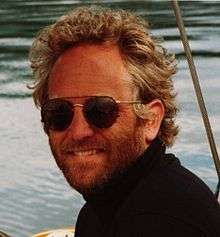Matthew Foreman
Matthew Dean Foreman is an American mathematician at University of California, Irvine. He has made notable contributions in set theory and in ergodic theory.
Matthew Dean Foreman | |
|---|---|
 | |
| Born | |
| Nationality | American |
| Alma mater | University of California, Berkeley |
| Scientific career | |
| Fields | Mathematics |
| Institutions | University of California, Irvine Ohio State University |
| Doctoral advisor | Robert M. Solovay |
Biography
Born in Los Alamos, New Mexico, Foreman earned his Ph.D. from the University of California, Berkeley in 1980 under Robert M. Solovay. His dissertation title was Large Cardinals and Strong Model Theoretic Transfer Properties.
In addition to his mathematical work, Foreman is an avid sailor. He and his family sailed their sailboat Veritas (a C&C) from North America to Europe in 2000. From 2000–2008 they sailed Veritas to the Arctic, the Shetland Islands, Scotland, Ireland, England, France, Spain, North Africa and Italy. Notable high points were Fastnet Rock, Irish and Celtic seas and many passages including the Maelstrom, Stad, Pentland Firth, Loch Ness, the Corryveckan and the Irish Sea. Further south they sailed through the Chenal du Four and Raz de Sein, across the Bay of Biscay and around Cape Finisterre. After entering Gibraltar, Foreman and his family circumnavigated the Western Mediterranean with notable stops in Barcelona, Morocco, Tunisia, Sicily, Naples, Sardinia and Corsica. In 2009, Foreman and his son and guest crew circumnavigated Newfoundland.[1] Foreman has been recognized for his sailing by twice winning the Ullman Trophy.[2]
Work
Foreman began his career in set theory. His early work with Hugh Woodin included showing that it is consistent that the generalized continuum hypothesis (see continuum hypothesis) fails at every infinite cardinal.[3] In joint work with Menachem Magidor and Saharon Shelah he formulated Martin's maximum, a provably maximal form of Martin's axiom and showed its consistency.[4][5] Foreman's later work in set theory was primarily concerned with developing the consequences of generic large cardinal axioms.[6] He also worked on classical "Hungarian" partition relations, mostly with András Hajnal.[7]
In the late 1980s Foreman became interested in measure theory and ergodic theory. With Randall Dougherty he settled the Marczewski problem (1930) by showing that there is a Banach–Tarski decomposition of the unit ball in which all pieces have the property of Baire (see Banach–Tarski paradox).[8] A consequence is the existence of a decomposition of an open dense subset of the unit ball into disjoint open sets that can be rearranged by isometries to form two open dense subsets of the unit ball. With Friedrich Wehrung, Foreman showed that the Hahn–Banach theorem implied the existence of a non-Lebesgue measurable set, even in the absence of any other form of the axiom of choice.[9]
This naturally led to attempts to apply the tools of descriptive set theory to classification problems in ergodic theory. His first work in this direction, with F. Beleznay,[10] showed that classical collections were beyond the Borel hierarchy in complexity. This was followed shortly by a proof of the analogous results for measure-preserving transformations with generalized discrete spectrum. In a collaboration with Benjamin Weiss [11] and Daniel Rudolph[12] Foreman showed that no residual class of measure-preserving transformations can have algebraic invariants and that the isomorphism relation on ergodic measure-preserving transformations is not Borel. This negative result finished a program proposed by von Neumann in 1932.[13] This result was extended by Foreman and Weiss to show that smooth area-preserving diffeomorphisms of the 2-torus are unclassifiable.
Foreman's work in set theory continued during this period. He co-edited (with Kanamori) the Handbook of Set Theory and showed that various combinatorial properties of ω2 and ω3 are equiconsistent with huge cardinals.[14]
In 1998 Foreman was an Invited Speaker of the International Congress of Mathematicians in Berlin.[15]
References
- Foreman, Zachary (2007) "Under Way", Cruising World Magazine, October 2007
- Tailwind, Balboa Yacht Club "Annual Awards", 2003, 2011
- Foreman, M.; Woodin, W. Hugh: The generalized continuum hypothesis can fail everywhere, Ann. of Math., (2) 133(1991), no. 1, 1–35
- Foreman, M.; Magidor, M.; Shelah, S.: Martin's maximum, saturated ideals, and nonregular ultrafilters. I, Ann. of Math. (2), 127(1988), no. 1, 1–47
- Foreman, M.; Magidor, M.; Shelah, S: Martin's maximum, saturated ideals and nonregular ultrafilters. II, Ann. of Math., (2), 127(1988), no. 3, 521–545.
- Foreman, M.; Ideals and generic elementary embeddings. Handbook of Set Theory, Vol 2, pp. 885-1147, Springer, 2010.
- Foreman, M; Hajnal, A.: A partition relation for successors of large cardinals, Math. Ann., 325(2003), no. 3, 583–623.
- Dougherty, R; Foreman, M. Banach–Tarski decompositions using sets with the property of Baire. J. Amer. Math. Soc. 7 (1994), no. 1, 75–124
- Foreman, M.; Wehrung, F. The Hahn–Banach theorem implies the existence of a non-Lebesgue measurable set. Fund. Math. 138 (1991), no. 1, 13–19.
- Beleznay, F.; Foreman, M. The collection of distal flows is not Borel. Amer. J. Math. 117 (1995), no. 1, 203–239.
- Foreman, M.; Weiss, B.: An anti-classification theorem for ergodic measure-preserving transformations, J. Eur. Math. Soc. (JEMS), 6(2004), no. 3, 277–292.
- Foreman, Matthew; Rudolph, Daniel; Weiss, Benjamin (May 1, 2011). "The conjugacy problem in ergodic theory". Annals of Mathematics. Annals of Mathematics. 173 (3): 1529–1586. doi:10.4007/annals.2011.173.3.7. ISSN 0003-486X.
- von Neumann, J. Zur Operatorenmethode in der klassischen Mechanik. Ann. of Math. (2), 33(3):587–642, 1932
- Foreman, Matthew: Smoke and mirrors: combinatorial properties of small cardinals equiconsistent with huge cardinals, Adv. Math., 222(2009), no. 2, 565–595.
- Foreman, Matthew (1998). "Generic large cardinals: New axioms for mathematics?". Doc. Math. (Bielefeld) Extra Vol. ICM Berlin, 1998, vol. II. pp. 11–21.